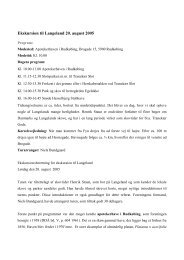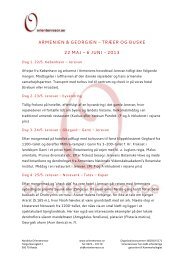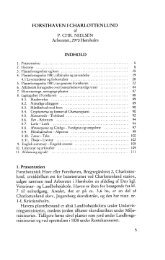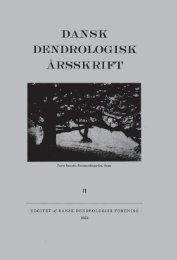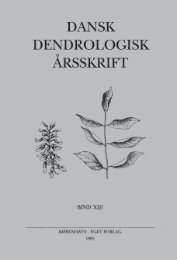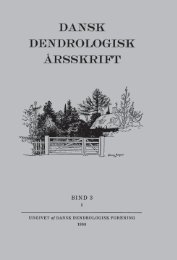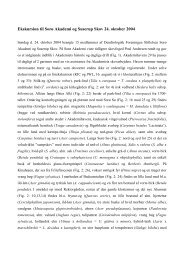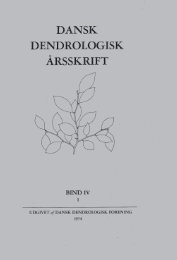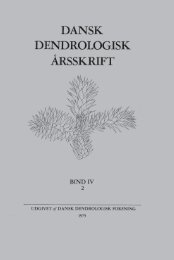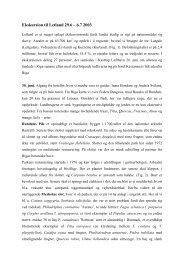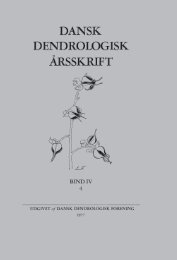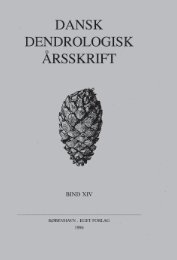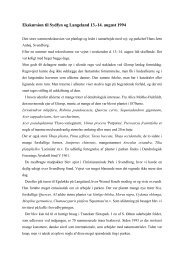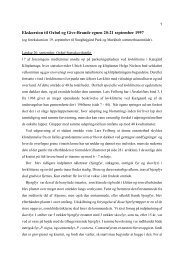Volume 2,1 (1963) - Dansk Dendrologisk Forening
Volume 2,1 (1963) - Dansk Dendrologisk Forening
Volume 2,1 (1963) - Dansk Dendrologisk Forening
You also want an ePaper? Increase the reach of your titles
YUMPU automatically turns print PDFs into web optimized ePapers that Google loves.
Lowiana with grandzs-pollen and got an offspring of several trees,<br />
having hardly any characters from the mother-tree.<br />
A. grandis is a coast-bound, lowland-tree with strictly dorsiventral,<br />
emarginate needles having shining and throughout furrowy upper<br />
surface. The twigs have a very flat parting on both sides, and the<br />
bark remains thin with large blisters.<br />
A. concolor is a mountaineous inland-type with isolateral, blunt,<br />
not emarginate needles with a dull, not at all furrowy upper surface.<br />
On the upper side of the twigs there is not any parting whatsoever. The<br />
bark is somewhat like that of grandis.<br />
A. Lowiana in the characters of the twigs and needles is quite intermediate<br />
between the two former, but the bark is more rough and<br />
with less pronounced resin-blisters when young. What has been said<br />
represents the common European type of Lowiana, but studies in<br />
the variation within concolor-types make it clear that intermediate<br />
forms can be found among them, and I hope and believe that future<br />
will disclose a series of intermediates between grandis and Lowiana<br />
growing in the natural forests of America.<br />
In spite of this supposed gradation between the three species I<br />
would prefer to consider them as true species because they, as far as<br />
I can see, have - each of them - well defined areas of distribution.<br />
5. Tsuga heterophylla (Raf.) Sarg. and T. Mertensiana (Bong.)<br />
Carr. are — apart from mistakes arising from their intricate nomenclatural<br />
history - even more distinct than the Afrzes-species, just mentioned.<br />
The latter represents such a queer type within Tsuga, that a<br />
French scientist seriously has suspected it to be of intergenetic hybrid<br />
origin ( Tsuga heterophylla X Picea sitchen-sis); but what is of interest<br />
to us is that Tsuga Jeffreyi(Henry) Henry is considered to be a hybrid<br />
betw een the Western and the Mountain Hemlock. It has been known<br />
from a few localities and was said to grow among the parents. T.<br />
heterophylla is easily recognised by its small, always dorsiventral, lanceovate<br />
needles, w 7 ith a very indistinct and irregular serration (at least<br />
on grownup specimens; young trees have a much more distinct and<br />
somewhat spiny serration. The cones are small and egg-shaped. The<br />
leading top-shoot is overhanging in the main part of its first year,<br />
and young trees prefer shade, avoiding too dry air and seems to be<br />
climax-trees on most forest-soils within the area of the Douglasfir,<br />
at least where the green and the not too grey types of Fir thrives<br />
well. It is found from the shore to high up in the mountains on<br />
their westward slopes reaching some hundred m below timberline.<br />
T. Mertensiana is a tall mountain tree, growing near to timberline



